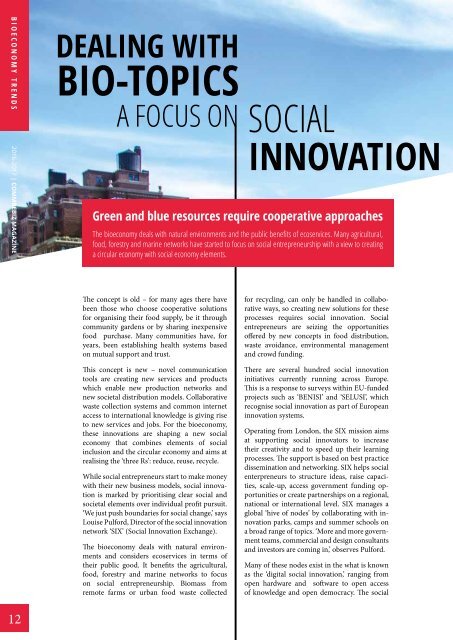BE INNOVATION_commbebiz-magazine 2016_2017
You also want an ePaper? Increase the reach of your titles
YUMPU automatically turns print PDFs into web optimized ePapers that Google loves.
BIOECONOMY TRENDS <strong>2016</strong>-<strong>2017</strong> | COMM<strong>BE</strong>BIZ MAGAZINE<br />
DEALING WITH<br />
BIO-TOPICS<br />
A FOCUS ON SOCIAL<br />
<strong>INNOVATION</strong><br />
Green and blue resources require cooperative approaches<br />
The bioeconomy deals with natural environments and the public benefits of ecoservices. Many agricultural,<br />
food, forestry and marine networks have started to focus on social entrepreneurship with a view to creating<br />
a circular economy with social economy elements.<br />
The concept is old – for many ages there have<br />
been those who choose cooperative solutions<br />
for organising their food supply, be it through<br />
community gardens or by sharing inexpensive<br />
food purchase. Many communities have, for<br />
years, been establishing health systems based<br />
on mutual support and trust.<br />
This concept is new – novel communication<br />
tools are creating new services and products<br />
which enable new production networks and<br />
new societal distribution models. Collaborative<br />
waste collection systems and common internet<br />
access to international knowledge is giving rise<br />
to new services and jobs. For the bioeconomy,<br />
these innovations are shaping a new social<br />
economy that combines elements of social<br />
inclusion and the circular economy and aims at<br />
realising the ‘three Rs’: reduce, reuse, recycle.<br />
While social entrepreneurs start to make money<br />
with their new business models, social innovation<br />
is marked by prioritising clear social and<br />
societal elements over individual profit pursuit.<br />
‘We just push boundaries for social change,’ says<br />
Louise Pulford, Director of the social innovation<br />
network ‘SIX’ (Social Innovation Exchange).<br />
The bioeconomy deals with natural environments<br />
and considers ecoservices in terms of<br />
their public good. It benefits the agricultural,<br />
food, forestry and marine networks to focus<br />
on social entrepreneurship. Biomass from<br />
remote farms or urban food waste collected<br />
for recycling, can only be handled in collaborative<br />
ways, so creating new solutions for these<br />
processes requires social innovation. Social<br />
entrepreneurs are seizing the opportunities<br />
offered by new concepts in food distribution,<br />
waste avoidance, environmental management<br />
and crowd funding.<br />
There are several hundred social innovation<br />
initiatives currently running across Europe.<br />
This is a response to surveys within EU-funded<br />
projects such as ‘<strong>BE</strong>NISI’ and ‘SELUSI’, which<br />
recognise social innovation as part of European<br />
innovation systems.<br />
Operating from London, the SIX mission aims<br />
at supporting social innovators to increase<br />
their creativity and to speed up their learning<br />
processes. The support is based on best practice<br />
dissemination and networking. SIX helps social<br />
enterpreneurs to structure ideas, raise capacities,<br />
scale-up, access government funding opportunities<br />
or create partnerships on a regional,<br />
national or international level. SIX manages a<br />
global ‘hive of nodes’ by collaborating with innovation<br />
parks, camps and summer schools on<br />
a broad range of topics. ‘More and more government<br />
teams, commercial and design consultants<br />
and investors are coming in,’ observes Pulford.<br />
Many of these nodes exist in the what is known<br />
as the ‘digital social innovation,’ ranging from<br />
open hardware and software to open access<br />
of knowledge and open democracy. The social<br />
12


